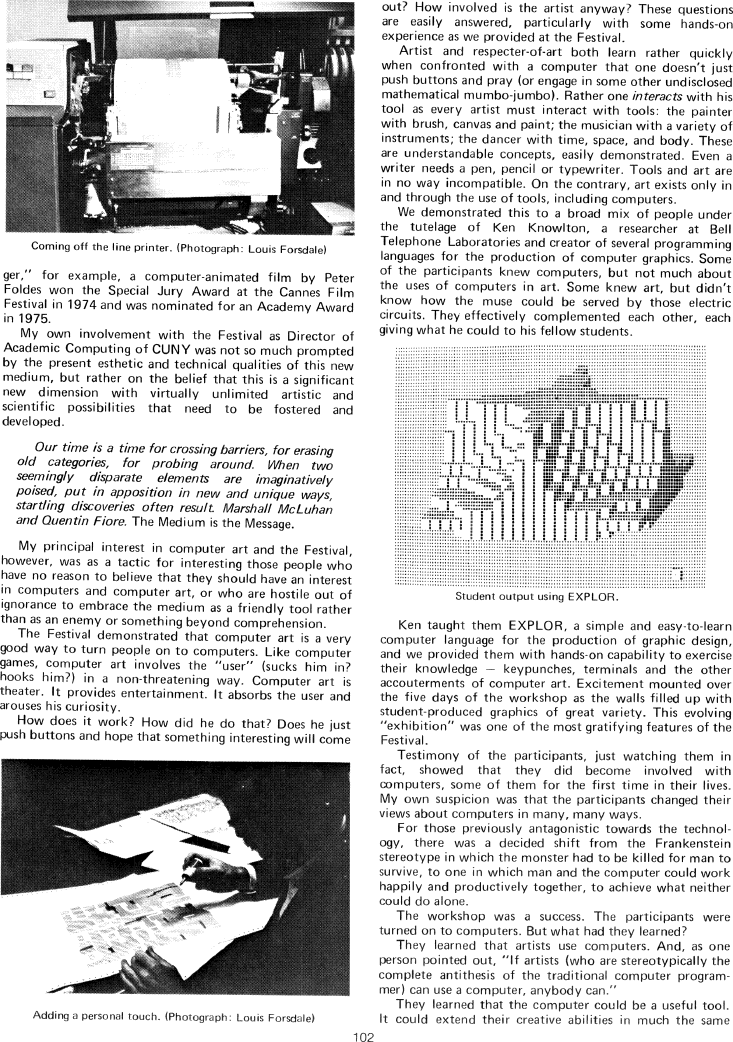The Best of Creative Computing Volume 1 (published 1976)
Turning On With Computer Art (EXPLOR computer language)

[image] Coming off the line printer, (Photograph: Louis Forsdale)
ger," for example, a computer-animated film by Peter Foldes won the Special Jury
Award at the Cannes Film Festival in 1974 and was nominated for an Academy Award
in 1975.
My own involvement with the Festival as Director of Academic Computing of CUNY
was not so much prompted by the present esthetic and technical qualities of this
new medium, but rather on the belief that this is a significant new dimension
with virtually unlimited artistic and scientific possibilities that need to be
fostered and developed.
Our time is a time for crossing barriers, for erasing
old categories, for probing around. When two
seemingly disparate elements are imaginatively
poised, put in apposition in new and unique ways,
startling discoveries often result. Marshall McLuhan
and Ouentin Fiore. The Medium is the Message.
My principal interest in computer art and the Festival, however, was as a tactic
for interesting those people who have no reason to believe that they should have
an interest in computers and computer art, or who are hostile out of ignorance
to embrace the medium as a friendly tool rather than as an enemy or something
beyond comprehension.
The Festival demonstrated that computer art is a very good way to turn people on
to computers. Like computer games, computer art involves the "user” (sucks him
in? hooks him?) in a non-threatening way. Computer art is theater. It provides
entertainment. It absorbs the user and arouses his curiosity
How does it work? How did he do that? Does he just push buttons and hope that
something interesting will come
[Image] – Adding a personal touch (Photograph: Louis Forsdale)
out? How involved is the artist anyway? These questions are easily answered,
particularly with some hands-on experience as we provided at the Festival.
Artist and respecter-of-art both learn rather quickly when confronted with a
computer that one doesn't just push buttons and pray (or engage in some other
undisclosed mathematical mumbo-jumbo). Rather one interacts with his tool as
every artist must interact with tools: the painter with brush, canvas and
paint; the musician with a variety of instruments; the dancer with time, space,
and body. These are understandable concepts, easily demonstrated. Even a writer
needs a pen, pencil or typewriter. Tools and art are in no way incompatible. On
the contrary, art exists only in and through the use of tools, including
computers.
We demonstrated this to a broad mix of people under the tutelage of Ken
Knowlton, a researcher at Bell Telephone Laboratories and creator of several
programming languages for the production of computer graphics. Some of the
participants knew computers, but not much about the uses of computers in art.
Some knew art, but didn't know how the muse could be served by those electric
circuits. They effectively complemented each other, each giving what he could to
his fellow students.
[Image] : Student output using EXPLOR
Ken taught them EXPLOR, a simple and easy-to-learn computer language for the
production of graphic design, and we provided them with hands-on capability to
exercise their knowledge - keypunches, terminals and the other accouterments of
computer art. Excitement mounted over the five days of the workshop as the walls
filled up with student-produced graphics of great variety. This evolving
"exhibition" was one of the most gratifying features of the Festival.
Testimony of the participants, just watching them in fact, showed that they did
become involved with computers, some of them for the first time in their lives.
My own suspicion was that the participants changed their views about computers
in many, many ways.
For those previously antagonistic towards the technology , there was a decided
shift from the Frankenstein stereotype in which the monster had to be killed for
man to survive, to one in which man and the computer could work happily and
productively together, to achieve what neither could do alone.
The workshop was a success. The participants were turned on to computers. But
what had they learned? They learned that artists use computers. And, as one
person pointed out, "If artists (who are stereotypically the complete antithesis
of the traditional computer programmer) can use a computer, anybody can.”
They learned that the computer could be a useful tool. It could extend their
creative abilities in much the same


